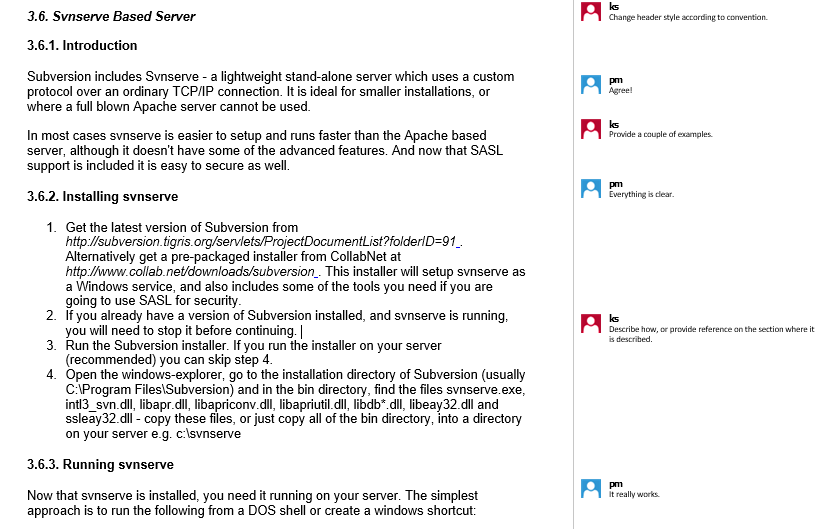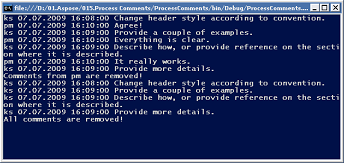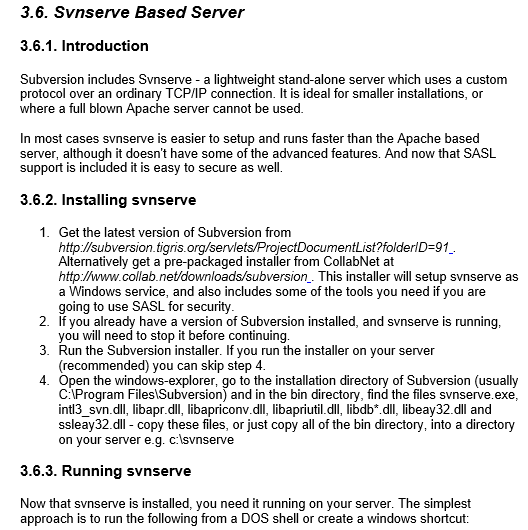Analyzing your prompt, please hold on...
An error occurred while retrieving the results. Please refresh the page and try again.
ลองออนไลน์
คุณสามารถลองฟังก์ชั่นนี้กับเรา ฟรีออนไลน์เอาคำอธิบายประกอบ.
Aspose.Wordsอนุญาตให้ผู้ใช้สามารถทำงานกับความคิดเห็น-ความคิดเห็นในเอกสารในAspose.WordsจะแสดงโดยCommentชั้ ใช้ชั้นเรียนCommentRangeStartและCommentRangeEndเพื่อระบุพื้นที่ของข้อความที่ควรจะเชื่อมโยงกับข้อคิดเห็น.
Aspose.Wordsช่วยให้คุณสามารถเพิ่มความคิดเห็นในหลายวิธี:
ตัวอย่างรหัสต่อไปนี้แสดงวิธีการเพิ่มความคิดเห็นในย่อหน้าโดยใช้คลาสComment:
ตัวอย่างรหัสต่อไปนี้แสดงวิธีการเพิ่มความคิดเห็นในย่อหน้าโดยใช้พื้นที่ของข้อความและCommentRangeStartและCommentRangeEndคลาส:
ใช้ความคิดเห็นในเอกสารคำ(นอกเหนือจากการติดตามการเปลี่ยนแปลง)เป็นวิธีปฏิบัติทั่วไ สามารถมีสถานการณ์ที่สิ่งเดียวที่คุณต้องการจากเอกสารเป็นความคิดเห็น. สมมติว่าคุณต้องการที่จะสร้างรายการของการค้นพบการตรวจสอบหรือบางทีคุณอาจจะได้ คุณอาจต้องการดูหรือลบความคิดเห็นของผู้ตรวจทานรายใดรายหนึ่ง.
ในตัวอย่างนี้,เราจะไปดูที่วิธีการบางอย่างง่ายสำหรับทั้งการรวบรวมข้อมูลจากความคิดเห็นภายในเอกสารและสำหรับการลบความคิดเห็นจากเอกสาร. โดยเฉพาะอย่างยิ่งเราจะครอบคลุมถึงวิธีการ:
รหัสในตัวอย่างนี้ค่อนข้างง่ายและวิธีการทั้งหมดจะขึ้นอยู่กับวิธีการเดียวกัน ข้อคิดเห็นในเอกสารคำจะแสดงโดยวัตถุCommentในรูปแบบวัตถุเอกสารAspose.Words ในการรวบรวมความคิดเห็นทั้งหมดในเอกสารให้ใช้วิธีการgetChildNodesกับพารามิเตอร์แรกที่ตั้งไว้ที่NodeType.Comment ตรวจสอบให้แน่ใจว่าพารามิเตอร์ที่สองของวิธีการgetChildNodesถูกตั้งค่าเป็นจริง:สิ่งนี้บังคับให้getChildNodesเลือกจา.
เพื่อแสดงให้เห็นถึงวิธีการแยกและลบความคิดเห็นจากเอกสาร,เราจะไปผ่านขั้นตอนต่อ:
เราจะใช้เอกสารคำต่อไปนี้สำหรับการออกกำลังกายนี้:

ที่คุณสามารถดูมันมีหลายความคิดเห็นจากสองผู้เขียนที่มีชื่อย่อ"น.“และ"แคนซัส”.
วิธีgetChildNodesมีประโยชน์มากและคุณสามารถใช้มันทุกครั้งที่คุณต้องการที่จะได้รับรายชื่อของโหนดเ คอลเล็กชันผลลัพธ์ไม่ได้สร้างค่าใช้จ่ายในทันทีเนื่องจากโหนดถูกเลือกไว้ในคอลเล็กชันนี้เ.
ตัวอย่างรหัสต่อไปนี้แสดงวิธีการแยกชื่อผู้เขียนวันที่และเวลาและข้อความของความคิดเห็นทั้งหมดในเอกสาร:
หลังจากที่คุณได้เลือกโหนดความคิดเห็นลงในคอลเลกชันทั้งหมดที่คุณต้องทำคือการแยกข้ ในตัวอย่างนี้ชื่อย่อวันที่เวลาและข้อความธรรมดาของความคิดเห็นจะรวมกันเป็นสตริงหนึ่ง;คุณสามารถเลือกที่จะเก็บไว้ในบางวิธีอื่นๆแทน.
วิธีการมากเกินไปที่แยกความคิดเห็นจากผู้เขียนโดยเฉพาะอย่างยิ่งเกือบจะเหมือนกันก็เ.
ตัวอย่างรหัสต่อไปนี้แสดงวิธีการแยกชื่อผู้เขียนวันที่และเวลาและข้อความของความคิดเห็นโดยผู้เขียนที่ระบุ:
หากคุณกำลังลบความคิดเห็นทั้งหมดไม่จำเป็นต้องย้ายผ่านคอลเล็กชันการลบความคิดเห็นทีละรายการคุณสามารถลบความคิดเห็นได้โดยโทรclearบนคอลเล็กชันความคิดเห็น.
ตัวอย่างรหัสต่อไปนี้แสดงวิธีการลบความคิดเห็นทั้งหมดในเอกสาร:
เมื่อคุณจำเป็นต้องเลือกลบความคิดเห็น,กระบวนการจะกลายเป็นคล้ายกับรหัสที่เราใช้ส.
ตัวอย่างรหัสต่อไปนี้แสดงวิธีการลบความคิดเห็นโดยผู้เขียนที่ระบุ:
จุดหลักที่จะเน้นที่นี่คือการใช้สำหรับผู้ประกอบการ ซึ่งแตกต่างจากการสกัดง่ายที่นี่คุณต้องการที่จะลบความคิดเห็น เคล็ดลับที่เหมาะสมคือการย้ำคอลเลกชันย้อนหลังจากความคิดเห็นล่าสุดไปยังคนแรก. ย้ายไปข้างหลังดัชนีของรายการก่อนหน้านี้ยังคงไม่เปลี่ยนแปลงและคุณสามารถทำงานใน.
ตัวอย่างรหัสต่อไปนี้แสดงวิธีการสำหรับการแยกความคิดเห็นและการเอาออก:
เมื่อเปิดตัวตัวอย่างจะแสดงผลลัพธ์ต่อไปนี้ ครั้งแรกที่แสดงความคิดเห็นทั้งหมดโดยผู้เขียนทั้งหมดแล้วจะแสดงความคิดเห็นโดยผู้เขียนที่เลือกเท่านั้น สุดท้ายรหัสลบความคิดเห็นทั้งหมด.

เอกสารคำที่ส่งออกได้ในขณะนี้ความคิดเห็นออกจากมัน:

ใช้Aspose.Wordsคุณยังสามารถลบความคิดเห็นระหว่างCommentRangeStartและCommentRangeEndโหนด.
ตัวอย่างรหัสต่อไปนี้แสดงวิธีการลบข้อความระหว่างCommentRangeStartและCommentRangeEnd:
วิธีการaddReplyเพิ่มการตอบกลับความคิดเห็นนี้ โปรดทราบว่าเนื่องจากข้อจำกัดของสำนักงานMSที่มีอยู่เพียงหนึ่ง(1)ระดับของการตอบกลับที่ไ ข้อยกเว้นของชนิดInvalidOperationExceptionจะถูกยกขึ้นถ้าวิธีนี้ถูกเรียกใช้ในการตอบกลับความคิดเห็นที่มีอยู่.
คุณสามารถใช้วิธีการremoveReplyเพื่อลบการตอบกลับที่ระบุในความคิดเห็นนี้.
ตัวอย่างรหัสต่อไปนี้แสดงวิธีการเพิ่มการตอบกลับความคิดเห็นและลบการตอบกลับของค:
Aspose.Wordsสนับสนุนการอ่านการตอบกลับของความคิดเห็น คุณสมบัติRepliesจะส่งคืนคอลเล็กชันของออบเจกต์Commentที่เป็นเด็กทันทีของข้อคิดเห็นที่ระบุ.
ตัวอย่างโค้ดต่อไปนี้แสดงวิธีการทำซ้ำผ่านการตอบกลับของความคิดเห็นและแก้ไขโค้ดเหล่:
Analyzing your prompt, please hold on...
An error occurred while retrieving the results. Please refresh the page and try again.